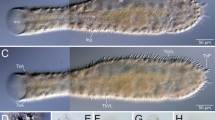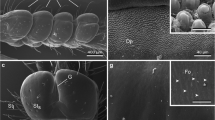Summary
The organization of the connective tissue of the polyclad turbellarian Discocelides langi has been studied using light microscopical, histochemical and electron microscopical techniques.
Filamentous components are found in the subepidermal membrane and in the body, especially around muscle cells. The subepidermal membrane is complex, consisting of an outer limiting component and the membrane proper. The membrane proper is composed of filamentous lamellae. The filaments, probably belonging to the collagen family of proteins, form an orthogonally arranged grid system.
Large amounts of ground substance are found in the interior of the body. Histochemical observations indicate that it probably consists of both neutral and acid polysaccharides in combination with protein components. On electron micrographs it presents itself as a finely granular to fibrillar net-like material of low density.
A frequently occurring component is a prominent system of membranous strands, composed of polysaccharide-protein materials. They are in continuity with and similar to cellular mucous coats or glycocalyx components.
The inherent difficulties in identification of connective tissue cells are discussed. In the peripheral parts of the animal, cells which are closely apposed, and reminiscent of planarian fixed parenchyma cells are found. In the interior parts cells similar to these are present but are embedded in ground substance. The cells often are large and branched and contain a cytoplasm with few organelles and of very low density on electron micrographs. Another type is strongly basophilic due to a high content of RNA. The fine structural morphology is very varied but is always characterized by the presence of a great number of ribosomes, either free or membranebound. This type possibly represents the formative cells responsible for synthesis of protein filaments and ground substance.
The connective tissue system found is discussed in relation to other types of turbellarian connective tissue. Also the functional implications are commented on.
Similar content being viewed by others
References
Andrew, W.: Textbook of comparative histology. New York: Oxford University Press 1959.
Bennett, H. S.: Morphological aspects of extracellular polysaccharides. J. Histochem. Cytochem. 11, 14–23 (1963).
: s-Collidine as a basis for buffering fixatives. J. biophys. biochem. Cytol. 6, 113–114 (1959).
Bock, S.: Studien über Polycladen. Zool. Bidr. Uppsala 2, 31–344 (1913).
Branwood, A. W.: The fibroblast. In: Int. Rev. Connective Tissue Res., vol. I (Ed. D. A. Hall). New York and London: Academic Press 1963.
Chapman, G.: The hydrostatic skeleton in the invertebrates. Biol. Rev. 33, 338–371 (1958).
Christensen, A. K.: Fine structure of an unusual spermatozoan in the flatworm Plagiostomum. Biol. Bull. 121, 416 (1961).
Clark, R. B.: Dynamics in metazoan evolution. The origin of the coelom and segments. Oxford: Clarendon Press 1964.
Dahlgren, U., and W. A. Kepner: A text-book of the principles of animal histology. New York: Macmillan Co. 1930 (electrotyped from ed. of 1908).
Dorey, A. E.: The cytology and micro-anatomy of acoelous turbellarians. Thesis University of Cambridge 1963.
Dorfman, A.: Polysaccharides of connective tissue. J. Histochem. Cytochem. 11, 2–13 (1963).
Edds jr., M. V., and P. R. Sweeny: Development of the basement lamella. In: Electron microscopy, vol. 2, QQ-2, (Ed. S. S. Breese jr.). New York and London: Academic Press 1962.
Gerschenfeld, H. M., F. Wald, J. A. Zadunaisky, and E. D. P. de Robertis: Function of astroglia in the water-ion metabolism of the central nervous system. Neurology (Minneap.) 9, 412–425 (1959).
Gross, J., Z. Sokal, and M. Rougvie: Structural and chemical studies on the connective tissue of marine sponges. J. Histochem. Cytochem. 4, 227–246 (1956).
Hay, E. D., and J. P. Revel: Autoradiographic studies of the origin of the basement lamella in Ambystoma. Develop. Biol. 7, 152–168 (1963).
Ito, S., and R. J. Winchester: The fine structure of the gastric mucosa in the bat. J. Cell Biol. 16, 541–577 (1963).
Jackson, S. F.: Connective tissue cells. In: The Cell, vol. VI (Eds. J. Brachet and A. E. Mirsky). New York and London: Academic Press 1964.
Kallmann, F., and C. Grobstein: Source of collagen at epitheliomesenchymal interfaces during inductive interaction. Develop. Biol. 11, 169–183 (1965).
Kramer, H., and G. M. Windrum: Sulphation techniques in histochemistry with special reference to metachromasia. J. Histochem. Cytochem. 2, 196–208 (1954).
Lang, A.: Die Polycladen (Seeplanarien) des Golfes von Neapel und der angrenzenden Meeresabschnitte. In: Fauna und Flora des Golfes von Neapel und der angrenzenden Meeres-Abschnitte. XI. Monographie. Leipzig: Wilhelm Engelmann 1884.
Luft, J. H.: Improvements in epoxy resin embedding methods. J. biophys. biochem. Cytol. 9, 409–414 (1961).
Maser, M. D., and R. V. Rice: Soluble earthworm cuticle collagen: a possible dimer of tropocollagen. J. Cell Biol. 18, 569–577 (1963).
Mowry, R. W.: Observations on the use of sulfuric acid in ether for the sulfation of hydroxyl groups in tissue sections. J. Histochem. Cytochem. 6, 82–83 (1958).
Nissing, K., u. W. Vogell: Elektronenmikroskopische Untersuchungen über Strukturveränderungen in der Hirnrinde beim Ödem und ihre Bedeutung für das Problem der Grundsubstanz. Z. Zellforsch. 52, 216–237 (1960).
Normann, T. C.: Staining thin sections with lead hydroxide without contamination by precipitated lead carbonate. Stain Technol. 39, 50–52 (1964).
Pedersen, K. J.: Studies on the nature of planarian connective tissue. Z. Zellforsch. 53, 569–608 (1961a).
: Studier over ferskvandstrioladernes cytologi. (With an English summary.) Copenhagen: Munksgaard 1961b.
: The cellular organization of Convoluta convoluta, an acoel turbellarian: A cytological, histochemical and fine structural study. Z. Zellforsch. 64, 655–687 (1964).
Picken, L.: The organization of cells and other organisms. Oxford: Oxford University Press 1960.
Porter, K. R.: Cell fine structure and biosynthesis of intercellular macromolecules. In: Connective tissue: intercellular macromolecules. London: J. & A. Churchill 1964.
Prenant, M.: Recherches sur le parenchyme des plathelminthes. Essais d'histologie comparée. Arch. Morph. 5, 1–174 (1922).
Rudall, K. M.: The distribution of collagen and chitin. Symp. Soc. exp. Biol. 9, 49–71 (1955).
Schneider, K. C.: Histologisches Praktikum der Tiere. Jena: Gustav Fischer 1908.
Skaer, R. J.: Some aspects of the cytology of Polycelis nigra. Quart. J. micr. Sci. 102, 295–317 (1961).
Weinstein, R., T. Abbiss, and S. Bullivant: The use of double and triple uranyl salts as electron stains. J. Cell Biol. 19, 74A (1963).
Weiss, P.: From cell to molecule. In: The molecular control of cellular activity (Ed. J. M. Allen). New York-Toronto-London: Mc Graw-Hill Book Co. 1962.
: The basement lamella of amphibian skin. Its reconstruction after wounding. J. biophys. biochem. Cytol. 2, Suppl. 275–282 (1956).
Wetzel, B. K.: Studies on the fine structure of regenerating Dugesia tigrina (Girard). Thesis Harvard University 1961.
Author information
Authors and Affiliations
Additional information
The author is indebted to Professor G. Thorson and Mrs. B. Kanneworff, M. Sc. for supplying the animals. The excellent technical assistance of Mrs. K. Bahnert and Mrs. R. Leth Hansen is greatly appreciated. Mr. R. E. Howells, B. Sc. kindly corrected the English manuscript.
Rights and permissions
About this article
Cite this article
Pedersen, K.J. The organization of the connective tissue of Discocelides langi, (Turbellaria, polycladida). Zeitschrift für Zellforschung 71, 94–117 (1966). https://doi.org/10.1007/BF00339832
Received:
Issue Date:
DOI: https://doi.org/10.1007/BF00339832




